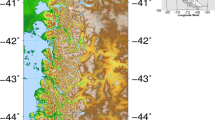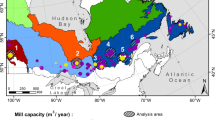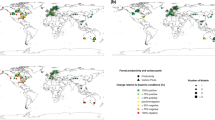Abstract
Possible effects of changing climate and increasing CO2 on forest stand development were simulated using a forest succession model of the JABOWA/FORET type. The model was previously tested for its ability to generate plausible community patterns for Alpine forest sites ranging from 220 m to 2000 m a.s.l., and from xeric to mesic soil moisture conditions. Each model run covers a period of 1000 yrs and is based on the averaged successional characteristics of 50 forest plots with an individual size of 1/12 ha. These small forest patches serve as basic units to model establishment, growth, and death of individual trees. The simulated CO2 scenario assumes linear climate change as atmospheric CO2 concentration increases from 310 μl/l to 620 μl/l and finally to 1340 μl/l. Direct effects of increasing CO2 on tree growth were modeled using tree-ring and growth chamber data. The simulation experiment proved to be a useful tool for evaluating possible vegetation changes that might occur under CO2-induced warming. On xeric sites from the colline to the high montane belt, the simulated climate change causes drastic soil water losses due to elevated evapotranspiration rates. This translates into a significant biomass decrease and even to a loss of forest on xeric low-elevation sites. Biomass gains can be reported from mesic to intermediate sites between 600 and 2000 m a.s.l. Increasing CO2 and warming alters the species composition of the simulated communities considerably. In today's montane and subalpine belt an invasion of deciduous tree species can be expected. They outcompete most conifers which in turn may migrate to today's alpine belt. Some of these changes occur as early as 40 yrs after climate begins to change. This corresponds to a mean annual warming of 1.5°C compared with today's mean temperatures.
Similar content being viewed by others
References
Amann, G. 1954. Bäume und Sträucher des Waldes. Neumann, Neudamm.
Bernatzky, A. 1978. Tree ecology and preservation. Elsevier, Amsterdam.
Bacastow, R. and Keeling, C.D. 1973. Atmospheric carbon dioxide and radiocarbon in the natural carbon cycle: Changes from AD 1700 to 2070 as deduced from a geochemical model. In: Carbon and the Biosphere, pp. 86–117. Edited by G.M. Woodwell and E.V. Pecan. Atomic Energy Commission report CONF-720510, Washington DC.
Björkman, O. and Pearcy, R.W. 1983. Physiological effects. In: CO2 and plants. Edited by E.R. Lemon. Westview Press, Boulder.
Botkin, D.B., Janak, J.F. and Wallis, J.R. 1972. Some ecological consequences of a computer model of forest growth. J. Ecol. 60: 849–872.
Bray, J.R. 1956. Gap-phase replacement in a maple-basswood forest. Ecology 37: 598–600.
Burnand, J. 1976. Quercus pubescens - Wälder und ihre ökologischen Grenzen im Wallis (Zentralalpen). Veröff. Geobot. Inst. ETH Zürich, Stiftung Rübel, No. 59.
Carlson, R.W. and Bazzaz, F.A. 1980. The effects of elevated CO2 concentrations on growth, photosynthesis, transpiration, and water-use efficiency of plants. In: Environmental and climatic impact of coal utilities. Edited by J.J. Singh and A. Deepak. Academic Press, New York.
Conroy, J.P., Smillie, R.M., Küppers, M., Bevege, D.I. and Barlow, E.W. 1986. Chlorophyll A fluorescence and photosynthetic and growth responses of Pinus radiata to phosphorus deficiency, drought stress, and high CO2. Plant Physiol. 81: 423–429.
Curtis, J.T. 1959. The vegetation of Wisconsin. Univ. of Wisconsin Press, Madison.
Dale, V.H. and Hemstrom, M. 1984. CLIMACS: A Computer Model of Forest Stand Development for Western Oregon and Washington. Res. Paper PNW-327. Pacific Northwest Forest and Range Experiment Station. USDA, Forest Service.
Dale, V.H. and Gardner, R.H. 1987. Assessing regional impacts of growth declines using a forest succession model. J. Environ. Manage. 24: 83–93.
Edig. Anstalt für das forstliche Versuchswesen (EAFV) 1988: Schweizerisches Landesforstinventar. Ergebnisse der Erstaufnahme 1982–1986. Eidg. Anst. forstl. Versuchswes. Ber. 305.
Ellenberg, H. 1979. Zeigerwerte der Gefässpflanzen Mitteleuropas. 2. ed. Scripta Geobotanica 9: 5–28; 37–122.
Ellenberg, H. 1982. Vegetation Mitteleuropas mit den Alpen in ökologischer Sicht. 3. ed. Ulmer, Stuttgart.
Flühler, H. 1981. Waldschäden im Walliser Rhonetal. Eidg. Anst. forstl. Versuchswes. Mitt. 57.
Forman, R.T.T. and Godron, M. 1981. Patches and structural components for a landscape ecology. BioScience 31: 733–740.
Gammon, R.H., Sundquist, E.T. and Fraser, P.J. 1985. History of carbon dioxide in the atmosphere. In: Atmospheric carbon dioxide and the global carbon cycle, pp. 27–62. Edited by J.R. Trabalka. Report DOE/ER-0239. U.S. Department of Energy, Washington.
Gates, D.M. 1985. Global biospheric response to increasing atmospheric carbon dioxide concentration. In: Direct effects of increasing carbon dioxide on vegetation. pp. 171–184. Edited by B.R. Strain and J.D. Cure. Report DOE/ER-0238. US Department of Energy, Washington.
Graybill, D.A. 1987. A network of high elevation conifers in the western U.S. for detection of tree-ring growth response to increasing atmospheric carbon dioxide. In: Proc. Int. Symp. on Ecological Aspects of Tree-Ring Analysis. 17–21 Aug. 1986. Palisades, N.Y. pp. 463–474. Edited by G.C. Jacoby Jr. and J.W. Hornbeck. Conference Report CONF-8608144. US Dept. of Energy, Washington DC.
Grove, J.M. 1988. The little ice age. Methuen, London.
Hari, P., Arovaara, H., Raunemaa, T. and Hautojarvi, A. 1984. Forest growth and the effects of energy production: A method for detecting trends in the growth potential of trees. Can. J. For. Res. 14: 437–440.
Holtmeier, F.K. 1980. Influence of wind on tree-physiognomy at the upper timberline in the Colorado Front Range. In: Mountain Environments and Subalpine Tree Growth. pp. 247–261. Edited by U. Benecke and M.R. Davis. Forest Research Institute Technical Paper No. 70. New Zealand Forest Service.
Hulme, M., Wigley, T.M.L., Jones, P.D. 1990. Limitations of regional climate scenarios for impact analysis. In: Proc. Europ. Conf. on Landscape ecological impact of climatic change. pp. 111–129. Edited by M.M. Boer and R.S. deGroot. IOS Press, Amsterdam.
Jacoby, G.C. 1986. Long-term temperature trends and a positive departure from the climate-growth response since the 1950s in high elevation lodgepole pine from California. In: Proc. of the NASA Conference on Climate-Vegetation Interactions, Greenbelt, Maryland, Jan 27–29, 1986, pp. 81–83. Edited by C. Rosenzweig and R. Dickinson. Report OIES-2. Office for Interdisciplinary Earth Studies (OIES), University Corporation for Atmospheric Research (UCAR), Boulder, Colorado.
Kienast, F. 1987. FORECE-a forest succession model for southern Central Europe. Report ORNL/TM 10575. Environmental Sciences Division. Publication No. 2989, Oak Ridge National Laboratory, Oak Ridge, TN 37830, USA.
Kienast, F. and Luxmoore, R.J. 1988. Tree ring analysis and conifer growth responses to increased atmospheric CO2 levels. Oecologia 76: 487–495.
Kienast, F. and Kuhn, N. 1989. Simulating forest succession along ecological gradients in southern Central Europe. Vegetatio 79: 7–20.
Kramer, P.J. 1981. Carbon dioxide concentration, photosynthesis, and dry matter production. BioScience 31: 29–33.
LaMarche, V.C. Jr., Graybill, D.A., Fritts, H.C. and Rose, M.R. 1984. Increasing atmospheric carbon dioxide: tree-ring evidence for growth enhancement in natural vegetation. Science 225: 1019–1021.
Luxmoore, R.J., O'Neill, E.G., Ells, J.M. and Rogers, H.H. 1986. Nutrient uptake and growth responses of Virginia Pine to elevated atmospheric carbon dioxide. J. Environ. Qual. 15: 244–251.
MacCracken, M.C. and Luther, P.M. (eds.) 1985. Detecting the climatic effects of increasing carbion dioxide. U.S. Department of Energy. Report DOE/ER-0235. Washington DC.
Manabe, S. and Stouffer, R.J. 1980. Sensitivity of a global model to an increase of CO2 in the atmosphere. J. Geophys. Res. 85: 5529–5550.
Manabe, S. and Wetherald, R.T. 1980. On the distribution of climate change resulting from an increase in CO2-content of the atmosphere. J. Atmos. Sci. 37: 99–118.
McLaughlin, S. and Bräker, O.U. 1985. Methods for evaluating and predicting forest growth responses to air pollution. Experientia 41: 310–319.
Mitchell, J.F.B. 1983. The seasonal response of a general circulation model to changes in CO2 and sea temperatures. QJR Meteorol. Soc. 109: 113–152.
Mitchell, J.F.B. and Lupton, G. 1984. A 4 × CO2 integration with prescribed changes in sea surface temperatures. Prog. Biometeorol. 3: 353–374.
Mitscherlich, G. 1970. Wald, Wachstum und Umwelt. Eine Einführung in die ökologischen Grundlagen des Waldwachstums. Sauerländer, Frankfurt a.M.
Moor, M., 1952. Die Fagion-Gesellschaften im Schweizer Jura. Beitr. geobot. Landesaufnahme der Schweiz. No. 31, Huber, Bern.
Ozenda, P., Borel, J.L. 1990. The possible responses of vegetation to a global climatic change. Scenarios for Western Europe, with special reference to the Alps. In: Proc. Europ. Conf. on Landscape ecological impact of climatic change. pp. 221–249. Edited by M.M. Boer and R.S. deGroot. IOS Press, Amsterdam.
Pastor, J. and Post, W.M. 1985. Development of a linked forest productivity-soil process model. Report ORNL/TM-9519. Environmental Sciences Division Publication 2455, Oak Ridge National Laboratory, Oak Ridge, TN 37830, USA.
Renner, F. 1982. Beiträgezur Gletschergeschichte des Gotthardgebietes und dendroklimatologische Analysen an fossilen Hölzern. Physische Geographie Vol. 8. Dept. of Geography, Univ. of Zurich, Switzerland.
Schmid, E. 1949. Vegetationskarte der Schweiz. Pflanzengeographische Kommission Naturforschende Ges. Schweiz, Bern.
Shugart, H.H. 1984. A theory of forest dynamics. Springer, New York.
Shugart, H.H. and Emanuel, W.R. 1985. Carbon dioxide increase: the implications at the ecosystem level. Plant, Cell and Environment 8: 381–386.
Shugart, H.H. and West, D.C. 1977. Development of an Appalachian deciduous forest succession model and its application to assessment of the impact of the chestnut blight. J. Environ. Manage. 5: 161–179.
Shugart, H.H. and West, D.C. 1980. Forest Succession Models. BioScience 30: 308–313.
Solomon, A.M. 1986. Transient response of forests to CO2-induced climate change: simulation modeling experiments in eastern North America. Oecologia (Berlin) 68: 567–579.
Solomon, A. and West, D.C. 1987. Simulating forest ecosystem responses to expected climate change in eastern north America: Applications to decision making in the forest industry. In: The greenhouse Effect, Climate change, and U.S. Forests, pp. 189–217. The Conservation Foundation, Washington.
Stein, N. 1978. Die standörtliche Verbreitung und klimaökolo-gische Abgrenzung waldbildender submediterraner (Quercus pubescens), subborealer (Pinus silvestris) und mitteleuropäisch-montaner Florenelemente (A bies alba) am Beispiel des mittleren Wallis (Zentralalpen). Geographica Helvetica 33: 93–112.
Stockton, C.W. 1984. An alternative hypothesis to direct CO2 fertilization as a cause of increased growth during 1850–1980 in Central Nevada. Preliminary report, Laboratory of Tree-Ring Research, Univ. of Arizona.
Trabalka, J.R. (ed.) 1985. Atmospheric carbon dioxide and the global carbon cycle. US Department of Energy Report DOE/ER-0239. Washington DC.
Watt, A.S. 1947. Pattern and process in the plant community. J. Ecol. 35: 1–22.
Wigley, T.M.L. and Jones, P.D. 1988. A climate scenario for Europe. Unpubl. manuscript for the preparation of case studies to the European conference on landscape ecological impact of climatic change. LICC secretariat, Utrecht, NL.
Williams, W.E., Garbutt, K., Bazzaz, F.A. and Vitousek, P.M. 1986. The response of plants to elevated CO2. IV. Two deciduous-forest tree communities. Oecologia 69: 454–459.
Author information
Authors and Affiliations
Rights and permissions
About this article
Cite this article
Kienast, F. Simulated effects of increasing atmospheric CO2 and changing climate on the successional characteristics of Alpine forest ecosystems. Landscape Ecol 5, 225–238 (1991). https://doi.org/10.1007/BF00141437
Issue Date:
DOI: https://doi.org/10.1007/BF00141437




